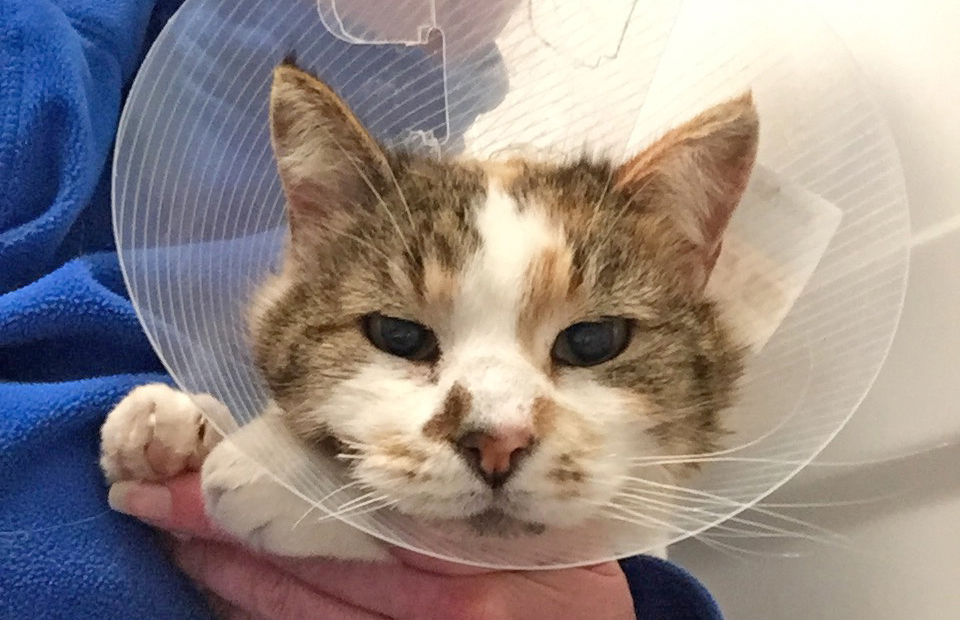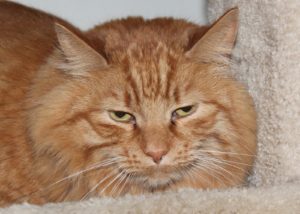

Prison Cats
Programs pairing last-chance cats with inmates are changing lives
In prisons, cats are transforming human lives. These aren’t therapy animals—they’re regular cats, and they’re working their uncertified magic in prisons, with transformative results. Cutting-edge programs are pairing inmates and unsocialized, last-chance cats, changing the trajectory for both. Prisoners are helping to rehabilitate stray and feral felines, and in the process are themselves changed.

Photo Spay Neuter Kingston Initiative
Bath Institution Feral Cat Colony, Kingston, ON
Overseen by Spay Neuter Kingston Initiative
Animal welfare advocate Joanne Boudreau’s heart was pounding as the prison gates at Kingston’s Bath Institution clanged shut behind her on a chilly day back in March 2010. Boudreau is the co-founder of Spay Neuter Kingston Initiative (snki.org), a non-profit dedicated to humanely reducing the cat overpopulation in Kingston, ON, and she and a colleague had come to inspect a cat colony on the prison grounds. There are no guards visible in this “pretty creepy” place, only 25 burly, bearded men towering on the stairs. They begin chanting “Save our cats! Save our cats!” One man yelled, “Are you going to help us?” The duo gave the inmates a thumbs up. A raucous “Yeahhhhhhh!” pierces through the biting winter wind. The men’s enthusiasm was heartwarming, recalls Boudreau. “I’ve never seen anything like it.,” she says.
“I was tickled pink.”
The cats, viewed as pests by the prison’s warden, had been slated for euthanasia until the outraged inmates circulated a petition to stop the slaughter. A media firestorm erupted, culminating in a deal— Spay Neuter Kingston Initiative (SNKI) would fix all the felines, try to find them homes, and oversee the veterinary care for the rest. In return, Canada Corrections Services would allow the rest of the animals to remain at Bath Institution.
Over a decade later, the inmates remain devoted to their charges, says Boudreau. They’ve built shelters for the cats, pay for their food, and keep close tabs on their health. When the animals require medical procedures, the guys, some of whom work odd jobs at the prison, pool their paychecks to raise money. Recently, they contributed $3,000 to pay for a senior cat’s dental work. “I don’t think they make that much money,” says Boudreau. “This shows the level of commitment these inmates have towards these kitties.”
But the benefits between the cats and the men flow both ways. “It gives them something to take care of,” says Boudreau. And, in an environment where perceived weakness can be deadly, the cats allow the men to express positive emotions safely. Witnessing these moments has been “nothing short of amazing,” says Boudreau.
An inmate’s ex-wife, Sophie Smith (names have been changed for privacy), has also witnessed the cats honing the inmates’ humanity. “A lot of them are in there for crimes against people,” she says. But the guys are very protective of all animals, including birds, squirrels, and even skunks, she says. “Except for the drug dog—they don’t like him.”
Their common vested interest in the felines has promoted teamwork amongst the men, says Smith. On one occasion, a cat, Big Mama, disappeared when she hitched a ride on a truck headed out of town. The inmates took to their phones en masse, calling tirelessly until the runaway was spotted and safely returned. The animals’ escapades also keep the guys entertained, says Smith. “It’s a break from the day-to-day monotony of being in prison.”
The cats have certainly turned around the life of her ex-husband, Jake Waters. After the cats came into his life, Waters’ spirits lifted. “He had purpose getting up each day,” says Smith. “He had his cat family to relate to.”
Over the years the colony has boosted Water’s empathy, says Sophie. Unlike humans, the cats are clueless about his past. “There’s no judgement from an animal,” she says. Particularly not when treats are involved—Jake earns these through his work at the prison and distributes them fairly to all members of the colony.
Not all cats have staked an equal claim to his heart, though. One chubby beauty is clearly his favourite. Waters plies her with compliments as he cuddles her close inside his jacket. It’s surreal for Smith to see the “big and tough” inmate turn into a “pussy cat” in the cat’s company. “It’s endearing,” says Smith.

Monroe Correctional Complex, Special Offenders Unit, Monroe, WA
Cat and Kitten Connections (Purrfect Pals Cat Shelter and Sanctuary)
It takes several days for the inmate at Monroe Correctional Complex to win over the shy black kitten who cowers under the bed. He’s not fazed, though. The man who grew up surrounded by fear and fury knows exactly how the kitten feels.
Gary (last name withheld for privacy) murmurs endearments to the cat and tosses him ball after ball. One morning he wakes up to find Prince snuggled beside him. He’s purring.
The prisoner and self-proclaimed loner—“I live in a unit of 47 other men yet I’m alone”—is overwhelmed by a rush better than any drug. “A warm feeling,” he calls it. Love.
Over 15 years, Gary has tamed 129 kittens and cats through the Cat and Kitten Connections foster program, which pairs under-socialized felines from Purrfect Pals Cat Shelter and Sanctuary in Arlington, WA (purrfectpals.org) with incarcerated fosters on the psychiatric unit, known as the Special Offenders Unit, at Monroe Correctional Complex (Monroe, WA). Since Purrfect Pals serves many shy and/or semi-feral animals, their cats are often passed over by potential adopters, says Susan Bark, the non-profit’s Foster and Intake Manager. But after spending time with inmates trained in socialization techniques, many animals are able to find a forever home in the community. Since the program’s inception in 2006, almost a thousand cats have been placed. The inmates also profit, says Bark. In the “sterile” world of beige uniforms and concrete floors, the cats supply a splash of colour. It’s a “win-win for everyone,” she says.
The chance to foster a feline has to be earned. The inmates must demonstrate solid coping skills and avoid infractions for a year before they’re entrusted with an animal. “That is a huge motivator for them,” says Cassidy Gebhardt, the clinical psychologist on site. Recently, one surly inmate who never returned her greetings crouched down and cooed to a batch of newly arrived kittens. He straightened, looked the psychologist in the eye, and asked “How do I get into the cat program?” Gebhardt was floored. “I had never even heard this gentleman speak before,” she says.
“They give me the strength to carry on.“
Purrfect Pals provides thorough training to the program’s newcomers. “Start out real slow,” is a key message, says Bark. The men learn to read a cat’s body language, paying heed to warning signs like dilated eyes or hissing. Next, they’re taught how to interact without touching the cat, by waving a feather wand or offering wet food on a spoon. As the cat gradually settles, the foster encourages desired actions by ignoring hostile behaviours and praising sociability. “Our goal is to be able to have this cat trust people,” says Bark.
But it isn’t just the cats who are absorbing the lessons. As the men witness the animals shifting from savage to civilized, they begin to spot the parallels with their own life choices, says Gebhardt. When they see the animals blossoming, this can ignite the men’s belief in their own potential for transformation. “And that helps them change their thinking about their attitudes,” says Gebhardt.
Gary too has gained guidance from his charges. The man who feels alienated amongst his own kind carries on long conversations with them in “Meow.” The “cat whisperer,” as he’s affectionately known among inmates and prison staff, tries to graft this facility onto human relations. “Communication…is one more aspect that I carry with me when with others not of the feline family,” he says.
Gary isn’t the only one whose fellowship with felines is improving his relationships with humans. Many men confined to prison feel rejected by their own kind, says Gebhardt. It’s easier for them to bond with the under-socialized animals also relegated to the fringes. Caring for the cats, however, is “their way of being able to give back,” says Gebhardt. As they begin to feel better about themselves, they’re more willing to engage with members of their own species.
The urgent needs of the cats also promote cooperation amongst the men. The fosters take turns cat-sitting the most colicky felines, and experienced participants like Gary share training tips with overwhelmed newbies. Upon a cat’s graduation, the foster writes a biography of its adopter, detailing everything from the cat’s food preferences to its affinity for other felines. Sometimes the new owners reciprocate with updates on the pet’s transition. These exercises in responsibility, selflessness, and community help model healthy relationships, so “they can be functioning members of society,” says Gebhardt.
For Gary, every cat he salvages is a step towards his own redemption. “For me, to rehabilitate a cat is to help myself,” he says. The animals have given him a taste of mutual trust and caring, and have helped to release him from the shackles of shame. Gary is dedicated to continue his journey of growth, counting on the cats to keep him on the straight and narrow. “They give me the strength to carry on,” he says.
Join the newsletter and never miss out on cat content again!
"*" indicates required fields
By clicking the arrow, you agree to our web Terms of Use and Privacy & Cookie Policy. Easy unsubscribe links are provided in every email.




